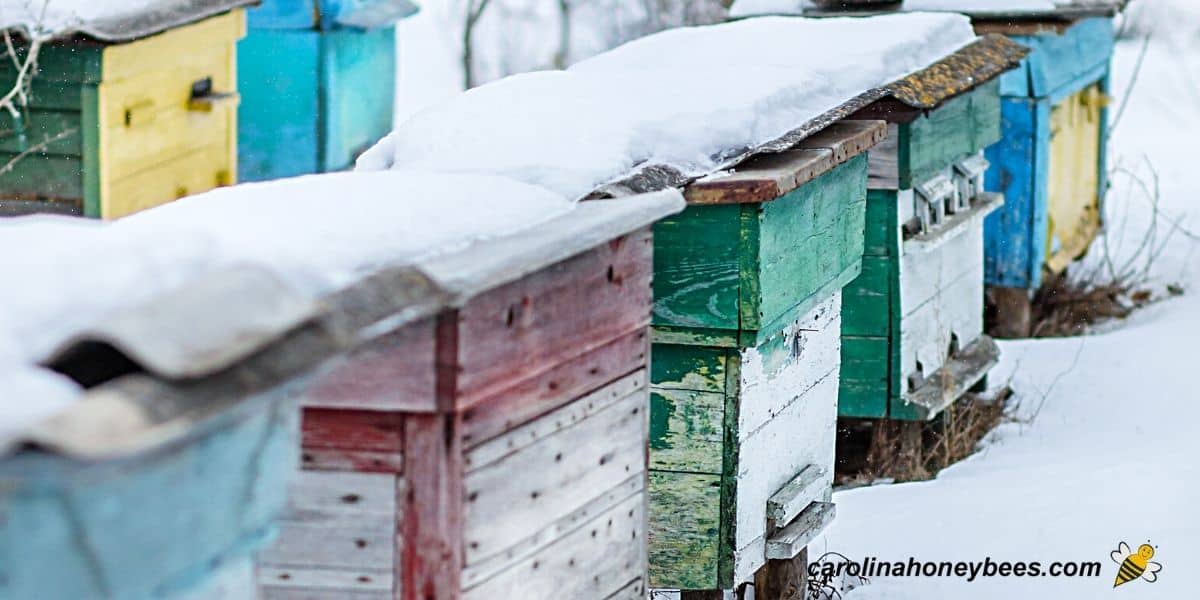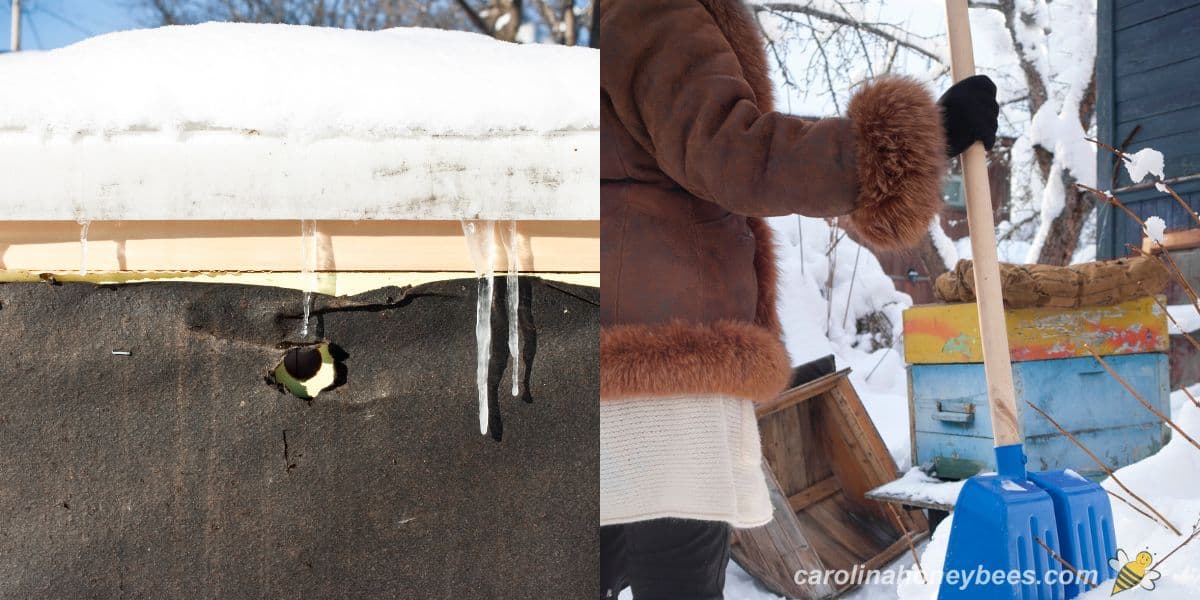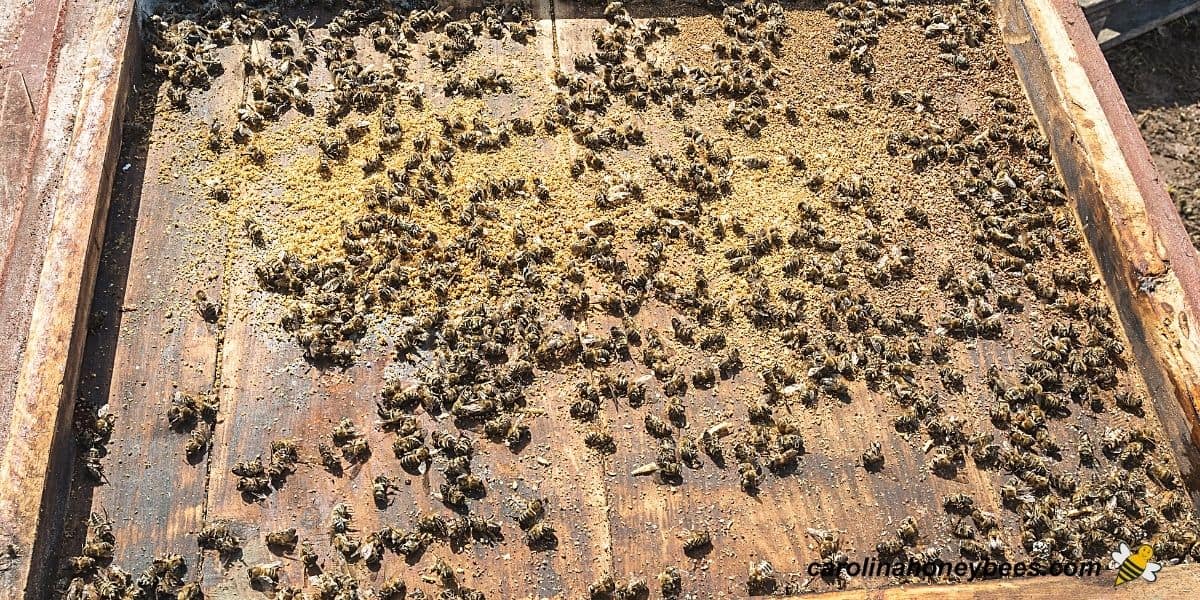Keeping Bees in Winter
Winter is a time of patience and careful observation for beekeepers. Once the hives are prepared for the cold, beekeeping in Winter represents a break from most hands-on tasks. But, that does not mean you can just forget about your colonies. During the cold months of the year, the beekeeper’s role becomes that of support. This guide covers essential tasks that can help your bees emerge strong, healthy and ready for Winter.

As a beekeeper, I love the Winter break – at least for a few months. But, practicing good beehive management even over Winter can make a big difference in survival numbers.
Winter Beekeeping Hive Management
Winter in the bee yard is typically a slower time with less activity for the bees and the keeper. But, of course we worry and hope that all is well.
In fact, wondering what is going on inside the hive is one of the biggest problems beekeepers face from December to March (or whatever your season may be).
Thankfully, you can help your colonies without always having to open the hive and remove frames. That is something we certainly avoid during cold weather.
Observe Hive Activity Without Opening the Hive
It is very easy to observe the hive entrance on warmer Winter days. Keep in mind that some breeds or types of honey bees fly at cooler temperatures due to genetics.
Still, if one colony has no activity while all the others are busy, you may need to do a quick check. Just pop the top and look in (with your veil on of course). A cluster of bees with just a bit of activity likely means they are okay.
Don’t be alarmed to see short periods of intense bee activity at the hive entrance – it’s probably just a “potty break”. It could also be an small orientation flight as a few new bees are produced in late Winter.
Some folks say you should never tap on a hive. But – more than one beekeeper has visited a hive during Winter and given a couple of taps on the side – with a ear pressed to the hive wall. A buzz tells us that someone is still alive in there.

Feeding Colonies During Winter
If your hives were properly winterized in the Fall, they may not need extra feeding. This should always be our goal.
Take a quick peak in the top of the hive. If you see lots of bees on top of the frames and no honey stores in the frames, it’s time for some emergency winter feeding.
Some beekeepers use wet sugar cakes, fondant or homemade candy boards made of sugar. Or you may try pouring a bit of granulated sugar in the hive.
In general, Winter is not the time to be feeding liquid syrup to your hive. It is best to not feed bees sugar water in cold weather.

Check Hive Entrance
Take a walk through the bee yard occasionally – to check that entrance reducers are not plugged with snow, ice or dead bees. Don’t be alarmed at a few dead bees.
Older bees will die and cold temps may prevent workers from clearing out the dead. You don’t want the bodies to block your entrance reducer.
If you use mouse guards on your hives, check to see that they are still in place and allow free movement of bees on warm days.
Good Hive Ventilation
Another problem that some beehives experience over Winter is too much moisture. If you have ever sit inside a car on a cold day – perhaps you experienced the windows fogging up.
In a similar fashion, the body processes of the live bees gives off moisture. With the occupants gathered together in a bee cluster for warmth – no workers are available to ventilate the hive.
Watch for any signs of excess moisture – water dripping from the hive entrance or water accumulating on the underside of the top cover.
Providing adequate hive ventilation before cold temperatures arrive can help with this problem.

Dealing with Winter Dead-Outs

We all struggle to help our colonies survive until Spring but some hives die. A dead Winter hive is often called a “dead out”.
There are many reasons beehives die during Winter. Too little food, no food in the right place, poor quality queens, and extreme moisture-all play a role in some cases.
Sometimes, the only thing you can do is clean up the dead hive and save what resources you can for next Spring.
Key Tasks for Winter Beekeeping
Some regions have long cold Winters and others experience a much shorter period of true Winter.
A healthy colony of fat Winter bees are not very active-at least to outward appearances. But, the beekeeper can keep busy. Beyond bee yard checks:
- store your beekeeping equipment so it will be ready to go next Spring
- do you need to wrap your hive for insulation? It may not be too late
- review some good beekeeping books. No one knows it all
- consider taking a beekeeping class
- order bees and new equipment
- repairing and painting beehives and equipment should be done now
- consider providing extra protein in late Winter buy or make your own pollen patties
FAQs
The biggest mistake made by beekeepers during Winter is forgetting to check on the hives at all. Even though beekeeping continues at a slower pace during the cold month, there are still tasks to perform.
Winter is not the time to start a beehive if you live in a cold region. However, beekeepers do have some tasks to perform while the bees are nestled inside the hive.
We have several apiary tasks to complete including monitoring the amount of honey stored in the hive, monitoring hive entrances and planning for Spring.
Hives should not be opened during Winter cold unless absolutely necessary. Even a few minutes of cold can kill developing brood.
Final Thoughts
For those of us who live in the South (USA), Winter beekeeping can be a beautiful thing. Finally, I can wear my beekeeping suit without fearing heat stroke. However, even Southern locations can experience cold temperatures and resulting colony loses.
Winter beekeeping will have its share of disappointments but those colonies that make it through will hopefully be healthy and ready to go in the new year.

